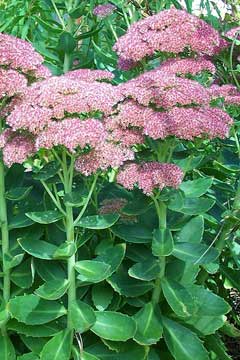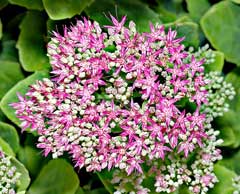 |
|
http://commons.wikimedia.org/wiki/User:Henrysalome |
 |
| http://commons.wikimedia.org/wiki/User:Aka |
Translate this page:
Summary
Physical Characteristics

 Sedum spectabile is a PERENNIAL growing to 0.4 m (1ft 4in) by 0.4 m (1ft 4in).
Sedum spectabile is a PERENNIAL growing to 0.4 m (1ft 4in) by 0.4 m (1ft 4in).
See above for USDA hardiness. It is hardy to UK zone 6 and is not frost tender. It is in flower from September to October, and the seeds ripen from October to November. The species is hermaphrodite (has both male and female organs) and is pollinated by Insects. The plant is self-fertile.
It is noted for attracting wildlife.
Suitable for: light (sandy), medium (loamy) and heavy (clay) soils, prefers well-drained soil and can grow in nutritionally poor soil. Suitable pH: mildly acid, neutral and basic (mildly alkaline) soils. It cannot grow in the shade. It prefers dry or moist soil and can tolerate drought.
UK Hardiness Map
US Hardiness Map
Synonyms
Hylotelephium spectabile. (Boreau.)H.Ohba.
Plant Habitats
Woodland Garden Sunny Edge; Ground Cover; Cultivated Beds; East Wall. In. South Wall. In. West Wall. In.
Edible Uses
Edible Parts: Leaves
Edible Uses:
Leaves - raw or cooked[105]. The leaves are very mucilaginous but have a fairly bland flavour[K].
References More on Edible Uses
Medicinal Uses
Plants For A Future can not take any responsibility for any adverse effects from the use of plants. Always seek advice from a professional before using a plant medicinally.
Antiphlogistic Depurative Sialagogue
The plant is antiphlogistic, depurative, sialagogue[147].
References More on Medicinal Uses
The Bookshop: Edible Plant Books
Our Latest books on Perennial Plants For Food Forests and Permaculture Gardens in paperback or digital formats.

Edible Tropical Plants
Food Forest Plants for Hotter Conditions: 250+ Plants For Tropical Food Forests & Permaculture Gardens.
More

Edible Temperate Plants
Plants for Your Food Forest: 500 Plants for Temperate Food Forests & Permaculture Gardens.
More

More Books
PFAF have eight books available in paperback and digital formats. Browse the shop for more information.
Shop Now
Other Uses
References More on Other Uses
Cultivation details
A very easily grown and tolerant plant, it succeeds in most soils[188] but prefers a fertile well-drained soil in a sunny position[200]. Tolerates poor soils[233]. Established plants are drought tolerant[200], they can also tolerate considerable neglect, surviving even in the dense growth of weeds[K]. Plants are hardy to about -20°c[187]. This species has pink flowers[200]. All members of this genus are said to have edible leaves, though those species that have yellow flowers can cause stomach upsets if they are eaten in quantity[62, 85]. The flowers have a honey-like smell similar to Buddleias[245]. A very ornamental plant[1], there are some named varieties[187]. The flowers are very attractive to bees and lepidoptera[30]. Plants in this genus seem to be immune to the predations of rabbits[233]. In garden design, as well as the above-ground architecture of a plant, root structure considerations help in choosing plants that work together for their optimal soil requirements including nutrients and water. The root pattern is fleshy. Thick or swollen - fibrous or tap root [2-1].
References Carbon Farming Information and Carbon Sequestration Information
Temperature Converter
Type a value in the Celsius field to convert the value to Fahrenheit:
Fahrenheit:
The PFAF Bookshop
Plants For A Future have a number of books available in paperback and digital form. Book titles include Edible Plants, Edible Perennials, Edible Trees,Edible Shrubs, Woodland Gardening, and Temperate Food Forest Plants. Our new book is Food Forest Plants For Hotter Conditions (Tropical and Sub-Tropical).
Shop Now
Plant Propagation
Seed - surface sow in spring in well-drained soil in a sunny position in a greenhouse. Do not allow the soil to dry out. Prick out the seedlings into individual pots when they are large enough to handle. If sufficient growth is made, it is possible to plant them out during the summer, otherwise keep them in a cold-frame or greenhouse for their first winter and plant them out in early summer of the following year[K]. Division is very easy and can be carried out at almost any time in the growing season, though is probably best done in spring or early summer. Larger divisions can be planted out direct into their permanent positions. We have found it best to pot up the smaller divisions and grow them on in a lightly shaded position in a cold frame, planting them out once they are well established in the summer. Cuttings at almost any time in the growing season. Very easy, even a single leaf will produce roots and form a new plant.
Other Names
If available other names are mentioned here
Native Range
TEMPERATE ASIA: China (Anhui Sheng, Hebei Sheng, Heilongjiang Sheng, Henan Sheng, Jilin Sheng, Liaoning Sheng, Shaanxi Sheng, Shandong Sheng), Korea
Weed Potential
Right plant wrong place. We are currently updating this section.
Please note that a plant may be invasive in one area but may not in your area so it's worth checking.
Conservation Status
IUCN Red List of Threatened Plants Status :

| Related Plants
|
| Latin Name | Common Name | Habit | Height | Hardiness | Growth | Soil | Shade | Moisture | Edible | Medicinal | Other |
| Sedum acre | Common Stonecrop, Goldmoss stonecrop, Gold Moss Sedum | Perennial | 0.1 |
4-9
| F | LMH | N | DM | 1 | 2 | 3 |
| Sedum aizoon | Sedum | Perennial | 0.4 |
4-10
| M | LMH | N | DM | 1 | 1 | |
| Sedum album | Small Houseleek, White stonecrop, Sedum, Stonecrop | Perennial | 0.1 |
6-8
| M | LMH | N | DM | 1 | 1 | 3 |
| Sedum anacampseros | Loce Restorer | Perennial | 0.1 |
5-9
| | LMH | SN | DM | 1 | 0 | 3 |
| Sedum arboroseum | Garden Stonecrop | Perennial | 0.5 |
5-9
| | LMH | SN | DM | 1 | 2 | |
| Sedum divergens | Pacific Stonecrop | Perennial | 0.2 |
5-9
| | LMH | N | DM | 1 | 1 | |
| Sedum forsterianum | Stonecrop | Perennial | 0.2 |
6-9
| | LMH | N | DM | 1 | 0 | |
| Sedum japonicum | | Perennial | 0.2 |
-
| | LMH | N | DM | 1 | 0 | |
| Sedum kamtschaticum | Orange stonecrop, Kamschataka Sedum, Kamschataka Stonecrop | Perennial | 0.1 |
4-10
| M | LMH | N | DM | 1 | 2 | 2 |
| Sedum lanceolatum | Spearleaf Stonecrop, Subalpine stonecrop | Perennial | 0.2 |
5-9
| | LMH | N | DM | 1 | 1 | |
| Sedum lineare | Needle stonecrop | Perennial | 0.3 |
6-9
| | LMH | N | DM | 1 | 1 | |
| Sedum makinoi | Stonecrop, Sedum | Perennial | 0.2 |
8-10
| M | LMH | N | DM | 1 | 2 | |
| Sedum oreganum | Oregon stonecrop | Perennial | 0.2 |
5-9
| | LMH | N | DM | 1 | 0 | 2 |
| Sedum rupestre | Crooked Yellow Stonecrop | Perennial | 0.1 |
6-9
| | LMH | SN | DM | 1 | 0 | 2 |
| Sedum sarmentosum | stringy stonecrop | Perennial | 0.1 |
6-9
| | LMH | N | DM | 1 | 1 | |
| Sedum sediforme | | Perennial | 0.5 |
7-10
| | LMH | N | M | 1 | 0 | |
| Sedum spathulifolium | Broadleaf Stonecrop, Purdy's stonecrop, Yosemite stonecrop, Stonecrop, Blood Leaf Sedum | Perennial | 0.1 |
6-10
| M | LMH | SN | DM | 1 | 1 | 3 |
| Sedum spurium | Caucasian Stonecrop | Perennial | 0.2 |
6-9
| | LMH | N | DM | 1 | 0 | 3 |
| Sedum stenopetalum | Wormleaf Stonecrop | Perennial | 0.2 |
5-9
| | LMH | N | DM | 1 | 1 | |
| Sedum stoloniferum | Stolon stonecrop, Sedum | Perennial | 0.2 |
7-9
| M | LMH | N | DM | 1 | 0 | |
| Sedum telephium | Orpine | Perennial | 0.5 |
4-8
| | LMH | FSN | DM | 1 | 2 | |
| Sedum ternatum | Woodland stonecrop or Wild stonecrop | Perennial | 0.2 |
3-9
| M | LMH | FSN | DM | 2 | 0 | 2 |
|
Growth: S = slow M = medium F = fast. Soil: L = light (sandy) M = medium H = heavy (clay). pH: A = acid N = neutral B = basic (alkaline). Shade: F = full shade S = semi-shade N = no shade. Moisture: D = dry M = Moist We = wet Wa = water.
Now available:
Food Forest Plants for Mediterranean Conditions
350+ Perennial Plants For Mediterranean and Drier Food Forests and Permaculture Gardens.
[Paperback and eBook]
This is the third in Plants For A Future's series of plant guides for food forests tailored to
specific climate zones. Following volumes on temperate and tropical ecosystems, this book focuses
on species suited to Mediterranean conditions—regions with hot, dry summers and cool, wet winters,
often facing the added challenge of climate change.
Read More
Expert comment
Author
Boreau.
Botanical References
200266
Links / References
For a list of references used on this page please go here
Readers comment
| Add a comment |
|
If you have important information about this plant that may help other users please add a comment or link below. Only comments or links that are felt to be directly relevant to a plant will be included. If you think a comment/link or information contained on this page is inaccurate or misleading we would welcome your feedback at [email protected]. If you have questions about a plant please use the Forum on this website as we do not have the resources to answer questions ourselves.
* Please note: the comments by website users are not necessarily those held by PFAF and may give misleading or inaccurate information.
To leave a comment please Register or login here All comments need to be approved so will not appear immediately.
|
Subject : Sedum spectabile
|
|
|
|